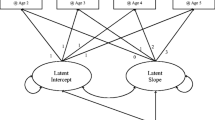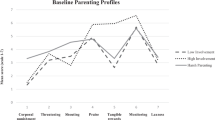Abstract
A selective prevention design was applied to 238 recently separated families. Of these, 153 mothers randomly assigned to the experimental (E) group participated in 14 group sessions focused on Parent Management Treatment (PMT). Prior analyses showed that, over time, the group of families in the untreated group deteriorated in both parenting practices and in child outcomes. In keeping with the classic prevention pattern, families in the E group showed modest improvements in parenting and in child outcomes. Improvements in parenting were associated with significant reductions in problem behavior. The data showed that those mothers who improved their parenting skills during the first 12 months also showed significant reductions in maternal depression during that same interval. A cross-lagged panel analysis showed that a reduction in maternal depression during the first year of the study was a significant predictor of maintenance or improvements over the next 18 months. The findings are consistent with the concept of the family as a system.
Similar content being viewed by others
REFERENCES
Achenbach, T. M. (1992). Revised Child Behavior Checklist. Burlington: University of Vermont.
Arnold, J. E., Levine, A. G., & Patterson, G. R. (1975). Changes in sibling behavior following family intervention. Journal of Consulting and Clinical Psychology, 43, 683-688.
Bien, N. Z., & Bry, N. H. (1980). An experimentally designed comparison of four intensities of school-based prevention programs for adolescents with adjustment problems. Journal of Community Psychology, 8, 110-116.
Block, J. H., Block, J., & Gjerde, P. F. (1986). The personality of children prior to divorce: A prospective study. Child Development, 57, 827-840.
Capaldi, D. M., & Patterson, G. R. (1994). Interrelated influences of contextual factors on antisocial behavior in childhood and adolescence for males. In D. Fowles, P. Sutker, & S. Goodman (Eds.), Progress in experimental personality and psychopathology research (pp. 165-198). New York: Springer.
Chase-Lansdale, P. L. (1995). The long-term effects of parental divorce on the mental health of young adults: A developmental perspective. Child Development, 66, 1614-1634.
Cherlin, A. J., Furstenberg, F. F., Jr., Chase-Lansdale, P. L., Kiernan, K. E., Robins, P. K., Morrison, D. R., et al. (1991). Longitudinal studies of effects of divorce on children in Great Britain and the United States. Science, 252, 1386-1389.
Conger, R. D., Patterson, G. R., & Gé, X. (1995). It takes two to replicate: A mediational model for the impact of parents' stress on adolescent adjustment. Child Development, 66, 80-97.
Curran, P. J., & Bollen, K. A. (2001). The best of both worlds: Combining autoregressive and latent curve models. In L. M. Collins & A. G. Sayer (Eds.), New methods for the analysis of change: Decade of behavior (pp. pp107-135). Washington DC: American Psychological Association.
DeGarmo, D. S., & Forgatch, M. S. (1997). Confidant support and maternal distress: Predictors of parenting practices for divorced mothers. Personal Relationships, 4, 305-317.
DeGarmo, D. S., & Forgatch, M. S. (1999). Contexts as predictors of changing maternal parenting practices in diverse family structures: A social interactional perspective to risk and resilience. In E. M. Hetherington (Ed.), Coping with divorce, single parenting and remarriage: A risk and resiliency perspective (pp. pp227-252). Hillsdale, NJ: Erlbaum.
DeGarmo, D. S., Patterson, G. R., & Forgatch, M. S. (2004). Why do parent training intervention outcomes maintain or wane over time? Prevention Science, 5, 73-89.
Eisenstadt, T. H., Eyberg, S., McNeil, C. B., Newcomb, K., & Funderburk, B. (1993). Parent-child interaction therapy with behavior problem children: Relative effectiveness of two stages and overall treatment outcome. Journal of Clinical Child Psychology, 22, 42-51.
Forehand, R., & Long, N. (1988). Outpatient treatment of the acting out child: Procedures, long-term follow-up data, and clinical problems. Advances in Behaviour Research and Therapy, 10, 129-177.
Forgatch, M. S. (1994). Parenting through change: A programmed intervention curriculum for groups of single mothers. Unpublished manuscript, Oregon Social Learning Center, Eugene.
Forgatch, M. S., Bullock, B. M., & Patterson, G. R. (2004). From theory to practice: Increasing effective parenting through role-play: The Oregon model of parent management training (PMTO). In H. Steiner, (Eds.), Handbook of mental health interventions in children and adolescents: An integrated developmental approach. (pp. 782-812). San Francisco: Jossey-Bass.
Forgatch, M. S., & DeGarmo, D. S. (1999). Parenting through change: An effective prevention program for single mothers. Journal of Consulting and Clinical Psychology, 67, 711-724.
Forgatch, M. S., & DeGarmo, D. S. (2002). Extending and testing the social interaction learning model with divorce samples. In J. B. Reid, G. R. Patterson, & J. Snyder (Eds.), Antisocial behavior in children and adolescents: A developmental analysis and model for inter-vention (pp. pp235-256). Washington, DC: American Psychological Association.
Forgatch, M. S., Knutson, N., & Mayne, T. (1992). Coder impressions of ODS lab tasks. Eugene: Oregon Social Learning Center.
Forgatch, M. S., & Marquez, B. (1993). The divorce workout [Videotape]. Eugene, OR: Oregon Social Learning Center.
Forgatch, M. S., Patterson, G. R., & Ray, J. A. (1996). Divorce and boys' adjustment problems: Two paths with a single model. In E. M. Hetherington & E. A. Blechman (Eds.), Stress, coping, and resiliency in children and families (pp. pp67-105). Mahwah, NJ: Erlbaum.
Forgatch, M. S., Patterson, G. R., & Skinner, M. L. (1988). Amediational model for the effect of divorce on antisocial behavior in boys. In E. M. Hetherington & J. D. Arasteh (Eds.), Impact of divorce, single parenting, and step-parenting on children (pp. pp135-154). Hillsdale, NJ: Erlbaum.
Gottman, J. M., & Roy, A. K. (1990). Sequential analyses: A guide for behavioral researchers. New York: Cambridge University Press.
Granic, I. (2000). The self-organization of parent-child relations: Beyond bidirectional models. In M. D. Lewis & I. Granic (Eds.), Emotion, development and self-organization: Dynamic systems approaches to emotional development (pp. pp267-297). New York: Cambridge University Press.
Hetherington, E. M. (1989). Coping with family transitions: Winners, losers, and survivors. Child Development, 60, 1-14.
Hetherington, E. M., & Clingempeel, W. G. (1992). Coping with marital transitions: A family systems perspective. Monographs of the Society for Research in Child Development, 57(2/3, Serial No. 227), 1-242.
Hollingshead, A. B. (1975). Four factor index of social status. Unpublished manuscript, Department of Sociology, Yale University, New Haven, CT.
Kazdin, A. E. (1997). Parent management training: Evidence, outcomes, and issues. Journal of American Academy of Child and Adolescent Psychiatry, 36, 1349-1356.
Lewis, M. D., & Granic, I. (Eds.) (2000). Emotion, development and self-organization: Dynamic systems approaches to emotional Development. New York: Cambridge University Pre
Martinez, C. R., Jr., & Forgatch, M. S. (2001). Preventing problems with boys' noncompliance: Effects of a parent training intervention for.Systematic Changes in Families 633 divorcing mothers. Journal of Consulting and Clinical Psychology, 69, 416-428.
Martinez, C. R., Jr., & Forgatch, M. S. (2002). Adjusting to change: Linking family structure transitions with parenting and child adjustment. Journal of Family Psychology, 16(2), 107-117.
McLoyd, V. C. (1998). Children in poverty: Development, public policy, and practice. In W. Damon, I. E. Sigel & K. A. Renninger (Eds.), Handbook of child psychology (5th ed., Vol. 4). New York: Wiley.
Patterson, G. R. (1980). Mothers: The unacknowledged victims. Monographs of the Society for Research in Child Development, 45(5, Serial No. 186).
Patterson, G. R. (1982). A social learning approach: Vol. 3: Coercive family process. Eugene, OR: Castalia.
Patterson, G. R. (1996). Some characteristics of a developmental theory for early onset delinquency. In M. F. Lenzenweger, & J. J. Haugaard (Eds.), Frontiers of developmental psychopathology (pp. pp81-124). New York: Oxford University Press.
Patterson, G. R., & Chamberlain, P. (1988). Treatment process: A problem at three levels. In L. C. Wynne (Ed.), State of the art in family therapy research: Controversies and recommendations (pp. 189-223). New York: Family Process Press.
Patterson, G. R., & Chamberlain, P. (1994). A functional analysis of resistance during parent training therapy. Clinical Psychology: Science and Practice, 1(1), 53-70.
Patterson, G. R., & Fleischman, M. J. (1979). Maintenance of treatment effects: Some considerations concerning family systems and follow-up data. Behavior Therapy, 10, 168-185.
Patterson, G. R., & Forgatch, M. S. (1985). Therapist behavior as a determinant for client resistance: A paradox for the behavior modified. Journal of Consulting and Clinical Psychology, 5, 237-262.
Patterson, G. R., & Forgatch, M. S. (1990). Initiation and maintenance of process disrupting single-mother families. In G. R. Patterson(Ed.), Depression and aggression in family interaction (pp. 209-245) Hillsdale, NJ: Erlbaum.
Patterson, G. R., Reid, J. B., & Dishion, T. J. (1992). A social interactional approach: Vol. 4: Antisocial boys. Eugene, OR: Castalia.
Price, R. H. (2003, June). Intervention as hypothesis: Learning from field experimental in the 'Winning New Jobs' program. Paper presented at Family Consortium III, “Prevention and Dissemination,” Santa Anna Pueblo, NM.
Radloff, L. S. (1977). The CES-D Scale: A self-report depression scale for research in the general population. Applied Psychological Measurement, 1, 385-401.
Reid, J. B., Patterson, G. R., & Snyder, J. (2002). Antisocial behavior in children and adolescents: A developmental analysis and model for intervention. Washington, DC: American Psychological Association.
Rusby, J. C., Estes, A., & Dishion, T. (1991). The Interpersonal Process Code (IPC). Unpublished manuscript, Oregon Social Learning Center, Eugene, OR.
Sameroff, A. J. (1989). Commentary: General systems and the regulation of development. In M. R. Gunnar & E. Thelen (Eds.), Systems and development: The Minnesota Symposia on Child Psychology (Vol. 22, pp. pp219-235). Hillsdale, NJ: Erlbaum.
Shaw, D. S., Emery, R. E., & Tuer, M. D. (1993). Parental functioning and children's adjustment in families of divorce: A prospective study. Journal of Abnormal Child Psychology, 21, 119-134.
Stoolmiller, M. S. (1995). Using latent growth curve models to study developmental processes. In J. M. Gottman (Ed.), The analysis of change (pp. pp105-138). Mahwah, NJ: Erlbaum.
Stoolmiller, M., Duncan, T., Bank, L., & Patterson, G. R. (1993). Some problems and solutions in the study of change: Significant patterns in client resistance. Journal of Consulting and Clinical Psychology, 61, 920-928.
U.S. Department of Commerce, Bureau of the Census. (1993). 1990 Census of population and housing: Population and housing characteristics for census tracts and block numbering areas (1990 CPH-3-144). Washington, DC: U. S. Government Printing Office.
Vinokur, A. D., Price, R. H., & Caplan, R. D. (1991). From field experiments to program implementation: Assessing the potential outcomes of an experimental intervention program for unemployed persons. American Journal of Community Psychology, 19, 543-562.
Vitaro, F., Brendgen, M., & Tremblay, R. E. (2001). Preventive inter-vention: Assessing its effects on the trajectories of delinquency and testing for mediational processes. Applied Developmental Science, 5, 201-213.
Webster-Stratton, C., Hollinsworth, T., & Kolpacoff, M. (1989). The long-term effectiveness and clinical significance of three cost-effective training programs for families with conduct-problem children. Journal of Consulting and Clinical Psychology, 57, 550-553.
Wothke, W. (2000). Longitudinal and multigroup modeling with missing data. In T. D. Little, K. U. Schnabel, & J. Baumert (Eds.), Longitudinal and multilevel data: Practical issues, applied approaches, and specific examples (pp. pp269-281). Mahwah, NJ: Erlbaum.
Author information
Authors and Affiliations
Rights and permissions
About this article
Cite this article
Patterson, G.R., DeGarmo, D. & Forgatch, M.S. Systematic Changes in Families Following Prevention Trials. J Abnorm Child Psychol 32, 621–633 (2004). https://doi.org/10.1023/B:JACP.0000047211.11826.54
Issue Date:
DOI: https://doi.org/10.1023/B:JACP.0000047211.11826.54




